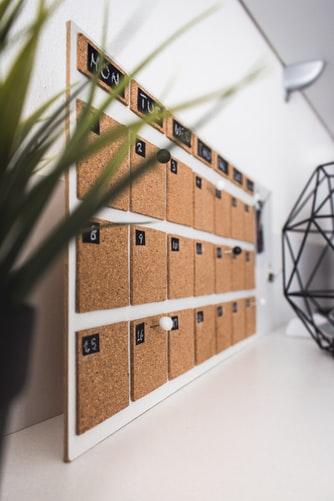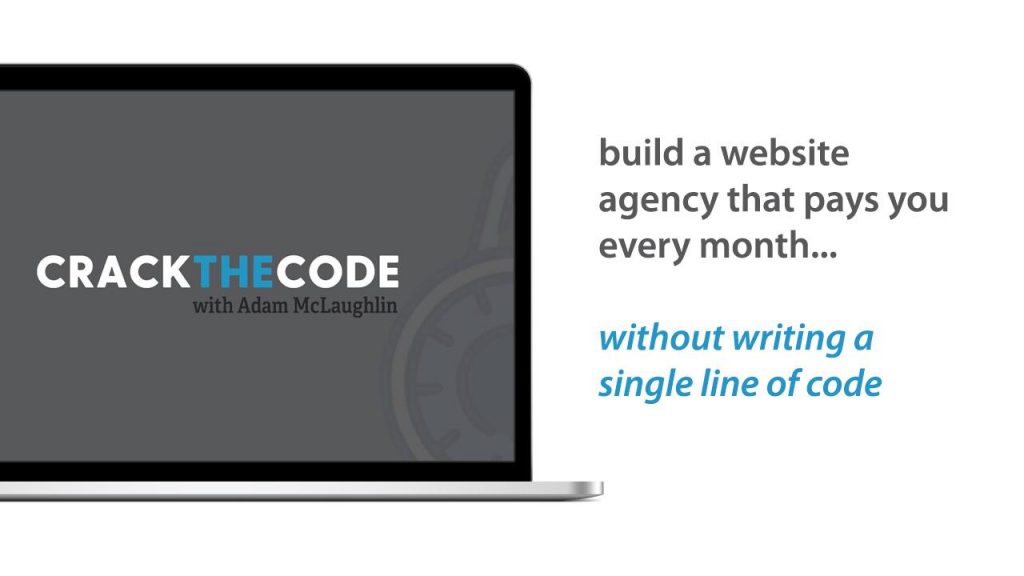Whether you’re a designer seeing a need for websites in your local small business community, or you’re in an industry that has a need for a web designer, or you’re looking to start a new business from scratch and exploring options (from Multi-level Marketing to network Marketing, to Shopify or Etsy), keep one thing in mind:
What is Your Goal in Starting a Business (more specifically, a Web Design Business)?
I started Fresh Idea Websites in 2011 because I wanted to create recurring income, have no inventory, do no recruiting, and be location independent. Websites are the perfect business for that.
As a bonus, I figured out quickly that I could outsource the parts of tech or design that I couldn’t do or when I got overloaded now and then without too much effort.
 While I started my business in 2011, it wasn’t until 2018 when we realized we wanted to travel all the time – not like vacation all the time, but buy an RV and travel full-time around the US and Canada (we’re Canadian, so we spend summers up there visiting friends and family).
While I started my business in 2011, it wasn’t until 2018 when we realized we wanted to travel all the time – not like vacation all the time, but buy an RV and travel full-time around the US and Canada (we’re Canadian, so we spend summers up there visiting friends and family).
We even spent a month in Mexico in January 2021 (not with the RV).
Fun Fact: I actually wrote up a business plan in 2011 to start my own takeout pasta buffet. Choose your noodles, choose your sauce, choose your toppings, then pay by weight. But, aside from the learning experience of writing my own business plan, I realized quickly that this didn’t really meet any of my business goals, so instead, I decided to launch Fresh Idea Websites.
It was easy for me to decide not to open a pasta restaurant based on my goals.
So what specifically are your business goals?
Why start a web design business (or at least consider it)? Sure, “make some money,” (and that’s a good idea) but more specifically?
 Is it to take control of your schedule and work 3 hours a day?
Is it to take control of your schedule and work 3 hours a day?- Is it to only need to work 3 days a week?
- Is it take a month off every year?
- Is it to buy yourself a new car every year?
- Maybe replace your current income doing something you’d prefer?
- Is it to work the same as you’re working now but double your income?
- Take every Friday off to volunteer?
- Maybe save up for that dream house?
- Give away $10,000 per month to charity?
Is your business goal a Lifestyle? Material? Travel? Philanthropic?
What is that goal for you – more than “schedule-freedom and money” – What is the tangible result of having freedom in your schedule and money?
Can starting a web design agency help you reach your business goal?
My gut is to tell you that it can, although I’m sure I’m biased, it’s been working for me. Websites can offer a recurring-income, no-inventory, no-recruiting, and location-independent business with a massive audience; every business needs one!
While RVing, we find people running all kinds of businesses from consulting to Etsy shops, online education, and network marketing (shout out to the essential oil industry). After seeing all of those options, if I were to start over, I’d stick with website design, but I would change a few things to scale faster and build recurring income quicker.
Things I would change if I were starting my web design business over:
Pick An Industry and Build Templates For Them
 When my business coach reads this, she’s going to roll her eyes. She told me this from the start, but it took a while to get it through my head. I wanted to say “Yes” to everything that came my way, but a custom business wasn’t in line with my goals.
When my business coach reads this, she’s going to roll her eyes. She told me this from the start, but it took a while to get it through my head. I wanted to say “Yes” to everything that came my way, but a custom business wasn’t in line with my goals.
Scalability isn’t in custom web design work; it’s in becoming the expert in an industry. Potential clients are more likely to trust experts than jack-of-all-trades graphic designers who build websites. (side note: Bookmark this post for ways to get new website design clients!)
Pick an industry, figure out what they need in their website, build 2 or 3 templates, and then sell as many of those as possible; Be the “website” expert in that industry.
The restauranteur or plumber, or welder in San Antonio doesn’t care if his or her website layout matches the business in Orlando or the client in Toronto. 99% of the time, that’s not their competition anyway.
Building templates will allow you to scale quickly by reproducing them over and over again – it’s the Ford model of producing cars, the Starbucks model of selling coffee with add-ons, or McDonald’s model of selling burgers and fries.
Since you’re selling customization to templates, your upfront costs are kept low so that you can keep your upfront costs to your clients low. In addition, this allows you to offer them an ongoing service package (sell the website as a service rather than a product), so you can build monthly recurring revenue rather than only making money upfront.
Monthly Recurring Model vs. Upfront Custom Work:
It’s nice to build recurring income per month, BUT I NEED MONEY NOW! That’s what a lot of my internal conversation sounded like when I started my business. As in most businesses, there is an onramp – like on a highway, the onramp takes you from zero to cruising speed, a business onramp is the amount of time to go from $0 income up to a sustainable level of income.
A model of building monthly recurring income with websites as a service is fewer peaks and valleys and more steady growth – so grow quickly.
 Here’s an actual example from my early days in my web design business. I sold 2 projects in the same month:
Here’s an actual example from my early days in my web design business. I sold 2 projects in the same month:
Website 1) The client insisted on paying for the website upfront and not paying a monthly service fee (someone inside their organization was going to take care of the website themselves). Admittedly, I was new to the business world and happy to make a sale. Still, I underpriced myself (because I only factored in design time, not “client hand-holding” time, revisions and reversals (really), approval through their board), and sold them their website for $3200.
Website 2) The client loved the service-based website model and was happy not to have to pay upfront. They were willing to model their website after one of the templates I had built. They paid $0 upfront and $99/month for their website.
Website 1 – completely custom took me about 100 hours with the initial design, revisions, approval processes with their board, etc. I made about $32/hour as an hourly rate, and it was done when we launched their site.
Website 2 – since I was customizing an existing template, I could write their text, resize and format their images, and adjust the color scheme to match their logo in 10 hours. Then the first month, I made $100 (or roughly $10/hour in that first month).
I’ve never seen another dime from site 1. Then, a few years after we launched, they asked for a quote on redoing the website. Knowing what I experienced the first time, they didn’t like my second quote.
Website 2 has been paying for their $99/month service contract for 8 years now. Every few months, they email and ask for a change to the site – add a product picture, or update their winter hours. It’s been evolving and doesn’t look much like how we started, and they’re happy to treat their website as a service or a utility for their business.
At this point, website 2 has paid me $1200/year for 8 years, or $9600 in service fees for their website service, and in return, they’ve never had to pay for a rebuild, and they keep telling me that the website generates more profit than it costs.
Now here’s the painful part:
What if instead of taking on Website 1, I built 10 ‘Website 2’s that month. My time invested that month would have been about the same, but I would have made a big difference for my bottom line in the long run – I would still be seeing the profit from that month.
Which Web Design Business Model would you choose?
Website 1 where you’ll have to scramble to sell another website in a month, or you don’t make anything, or website 2: Build a template that works for a specific industry and scale quickly to make recurring income and long-term business stability?
This is why you choose an industry and sell web design templates
In the example above, the only way I can sell and produce 10 of those websites per month is if I’m not building each one custom – I have to customize templates to make that work, and clients understand that you’re not needlessly building from scratch and then passing on those costs to them.
In my online course, “Crack The Code; Build a web design business without writing a line of code,” I talk about how to help clients understand the value of selling web design from templates and overcoming the objection that a template is a starting point is “going to look just like everyone else’s website.”
Usually, I recommend 3 templates: “Good, Better, Best.” This gives the client some more choice and gives you a few pricing levels to serve different clients; then, each template gets customized with the client’s images, text, contact info, and color scheme to match their logo.
How to choose an industry or niche for your web design business
 It’s not just enough to build templates, but you have to build templates that specifically serve an industry or niche. A template for a pizza restaurant won’t also work as a template for a shoe store, and a template for a summer camp, and a template for a hotel.
It’s not just enough to build templates, but you have to build templates that specifically serve an industry or niche. A template for a pizza restaurant won’t also work as a template for a shoe store, and a template for a summer camp, and a template for a hotel.
To truly become the expert in an industry, you have to know that industry inside and out; Often an industry that you grew up in, or you’ve worked in, or you have a specific interest in.
I would shy away from choosing an industry simply because you see a need. The people in that industry will see through opportunism if you don’t really get the industry or understand their needs.
Narrow your focus to a segment within a segment of your industry
That’s not a typo in the title. Figure out the industry you’re going to serve, then choose a segment of that industry, then choose a smaller segment within that segment, whether that starts as serving a small business, or going after one large company at a time.
Not just restaurants, or narrowed to pizza restaurants, but pizza restaurants that are not chains that sell an organic menu.
Not just the automotive industry, or narrowed to mechanics, but mechanics who work on European-made passenger cars.
Not just hotels, but hotels that are not chains, and are family-friendly and have an on-site restaurant.
Really focussing on who you want to serve will allow you to build templates that serve their specific needs and become the “go-to” person in the industry to get a website from.
Which Hats Are You Going to Wear in your web design business?
 It wasn’t soon enough when I realized I couldn’t wear all 4 hats in my business. I would have grown a lot quicker earlier on if I’d made this realization. The 4 hats in a web design business:
It wasn’t soon enough when I realized I couldn’t wear all 4 hats in my business. I would have grown a lot quicker earlier on if I’d made this realization. The 4 hats in a web design business:
- Sales & Marketing
- Design
- Technical
- Business Administration
My secret: Wear as few hats as you can, but max out at 2 hats. Eventually, you’ll want to grow to the point where you can oversee, explore new industry opportunities, and be in charge of the growth strategy for your business while everyone else is executing, but to start with, find a partner (or a white-label web design and tech support agency like ours) to outsource your other hats.
What do I need to start a web design business? Your Brand and Website
Now that you’ve figured out the industry you’ll serve and narrowed it down to a segment of a segment; you’ll be able to name your business in a way that resonates with your industry. There are 3 options:
- Consider something that is a keyword or catchphrase in your industry. “Rubber Sole Websites” might a cheesy name, but it will point to your industry clearly. (and I’m sure you’ll think of something much better than I can off the top of my head)
- Go with something obvious. One of our brands is “CoffeeShopWebsites.net” – it’s so obvious, and obviousness brings with it clarity.
- Choose something that is your name/partnership. If you’re already well-known in your industry, and your name is fairly recognizable, then consider using your name or your partnership and add something like “Creative” or “Digital” or “Web Design” after it to indicate what this venture is about. For example, “LastNameDigital” or “LastNameWebsites” may be the best way for people to remember your brand and associate it with what you do.
Next, find a domain name and build (or outsource the building of) your website for your brand.
Make sure that your imagery points clearly to your industry, repeatedly mention that you’re offering websites as a service so potential clients understand that before they call, and give a clear way that people can request a quote from you.
The checklist for your marketing website is included free in my online course: Build That Agency: Learn to build a recurring income web design business without writing a single line of code.
A few key points for a successful web design for your marketing site:
- Be clear in many locations on your site and many different ways of reiterating that you’re offering an ongoing service, not a product that someone will purchase upfront as a lump sum.
- Use images that clearly define your target audience (if you target mechanics, use images that instantly say “mechanic”, if your target is food trucks, use images that say “Food Trucks”- I like to get free stock photos from unsplash.com as often as I can find what I’m looking for). Anything else can look generic and confusing. Don’t think that because you’re a web design business that you should use all photos of people on their laptops.
- Drive home your business name with something that matches your industry – something memorable!
- Have a “Request A Quote” form on your website where businesses can request a quote for your services.
- Highlight why YOU are an expert in the industry that you serve, the skills you have, and the value of working with you rather than other web designers.
- As soon as you have portfolio projects and personal testimonials from business owners, highlight them on the home page.
How Do Web Designers Get New Clients? Most Don’t.
 This may seem odd, but often the first clients are the ones that fall into your lap easiest. In many cases, running a web design business wasn’t even in the plans when the first client says “I saw you built a personal blog, or put together a website for your family business. Can you do that for me?” Next thing you know, someone who knows a thing or two (and often doesn’t even have business cards yet) is starting a web design business, even if that small business is a side hustle.
This may seem odd, but often the first clients are the ones that fall into your lap easiest. In many cases, running a web design business wasn’t even in the plans when the first client says “I saw you built a personal blog, or put together a website for your family business. Can you do that for me?” Next thing you know, someone who knows a thing or two (and often doesn’t even have business cards yet) is starting a web design business, even if that small business is a side hustle.
It’s sad but true. Most web designers find a few people they could connect with to be clients- maybe a friend who owns a business, or someone they met at a networking event – and end up closing up shop in less than a year because they’ve spent their time designing for the paycheck, then once they get paid, they have to start finding new clients, which isn’t profitable until you get that next deposit. They haven’t made a regular habit of cultivating new client relationships while building out the last client’s project.
While it’s rarely my goal to go a month without bringing on additional clients, even if I take it easy for a month, our business still has a stable income because of our monthly service-based model.
In the Build That Agency Course, my model points to be industry-specific which not only helps with the design and technical side of offering templates but also allows you to clearly define your target audience and how to get in front of decision-makers in your industry so you can keep the clients coming in as you’re getting existing client websites live.
Free and Paid ways to get New Web Design Clients:
Free Options:
- Join Facebook groups for your industry to meet potential clients online
- Volunteer to be a guest on industry-related podcasts
- Write guest posts for magazines, blogs, or publications that are going to be read by your audience
- Blog on your own business’ website to show credibility and expertise
- Go to a networking event and create friendships with as many businesses as you can, even if they’re not your niche. They may know someone who is!
- Register Social Media channels for your business and 80% of the time post content that people in your industry would find helpful. The other 20%, post about customers you’re working with, a project or a job you’ve recently launched, highlight successful testimonials where you’ve added value to a business, and talk about the process of using your specific tools to help businesses meet their online goals.
- Have a business website that has foundational search engine optimization (SEO) in place.
- Offer to build a website using one of your pre-made design templates for an influential person in your industry in exchange for promotion and marketing.
- Ask friends and family if they know any businesses that would be a fit for your services and could offer a personal referral.
- Offer your first clients an incentive for successful referrals to new customers – a free month of your web design service, a gift card to a coffee shop of their choice, or some other value or tool that businesses in your niche would appreciate.
Paid Options:
- Pay for advertisement in an industry email newsletter in your niche
- Purchase a banner ad on a popular industry blog for your web design business
- Ask an industry leader if you can pay them to post about your services online through social media for other business owners to see.
- Get business cards printed and rent a booth at an industry conference or convention.
- Attend networking events for your industry
- Start your own industry “Lunch and Learn” on Zoom and invite relevant speakers to promote their practice, blog, latest book, new product, or podcast. (Be sure to promote the lunch and learn on social media, and ask your speakers to invite their business audience to join also.)
- Hire someone to use social media ads to reach decision-makers, business owners, and potential clients in your target audience.
Software Tools For Your Web Design Company
Project Management Tools
There are plenty of project management options if you want to start a business. I use trello. If you’d like to try it out for free, here’s a link: https://trello.com/adammclaughlin1/recommend (affiliate link)
You don’t have to use trello, but I would recommend using something. Some of the salespeople that we white label work for have 8-10 projects at various stages at any given time, so simply trying to keep track of all of that with your email inbox won’t work, and then involving our team could just make things more complicated if we didn’t have one centralized workspace that we could all reference.
Recurring Invoice Accounting Software
When choosing an accounting tool, be sure to select one that allows for automatic recurring invoices so you don’t have to retype every invoice on the first of every month.
There are lots of options. I use freshbooks.com (Affiliate link) as a personal favorite for how it integrates with an iPhone app.
If you’re a web designer, you’ll need web design software
Remember that you don’t have to be a web designer to have a company like ours ‘white-label’ your design and technical service, but if you ARE going to be DIY in your design business full time, then you’ll need to know a web design software inside and out to properly serve your clients.
There are many options like WordPress, Wix, Squarespace, or Joomla that can be used to create a website for your clients. If you’re really intent on being a designer, then our favorite recommendation is WordPress coupled with themes (or templates) from Elegant Themes (aff link), since you have plenty of customization, but it’s an established system, so you’re not always starting from scratch.
Unless you have a partner that is driving sales, it’s not efficient to spend time learning design skills at the same time as learning to grow your business. If you’re already running a web design business and wanting to transition to a recurring income model, or you know exactly what you’re doing with the design software of your choice, then wearing both the sales and the design hat may work for you and your customers.
Important Terms to Learn When Starting A Web Design Business:
Design and Development – are they the same or even related?
 Web design is putting together the layout of a website, choosing colors, making sure the final product looks good on mobile devices, etc. Web Development is writing code that acts like software – an employee login for time tracking, a client login so they can see their project’s progress, or tools that do a customized function other than displaying text and pictures.
Web design is putting together the layout of a website, choosing colors, making sure the final product looks good on mobile devices, etc. Web Development is writing code that acts like software – an employee login for time tracking, a client login so they can see their project’s progress, or tools that do a customized function other than displaying text and pictures.
We’re designers, not developers, so we try to help clients find software that already does what they’re looking for rather than writing something from scratch. It’s better for the client to pay a monthly subscription to the tool they need rather than going through the process of project management and writing it themselves (or you could include a tool in your monthly services to the client so they just pay a single package to get your web design and the tool they need for the job).
Clients come up with all kinds of exciting ideas (especially small business clients who are excited about the process of getting their new web design). Instead of trying to figure out a way to be the project management and hire a web developer, stick with your templates, and have some recommendations up your sleeve (and maybe some affiliate links) to know what other tools and software are available for your niche.
What is a Domain Name?
A domain name is another word for a website address. It’s where you tell people to go when you want them to visit your website. Domain names need to be renewed (it’s not a purchase, it’s closer to a lease) and the registration can be for as little as 1 year which needs to be renewed yearly, or you can register the domain for longer like 5 or 10 years.
Register your clients’ domain names for them (Google is the simplest option for this), and include the yearly renewal cost in their service package. This allows you to be sure that the client isn’t going to forget and someone else takes the domain if it’s not renewed, and you get to assure that client that there are no costs outside of their services with you.
What is website hosting?
When someone types in a website address, the text and image files that they see are sitting on a computer somewhere (called a server) and the internet database knows that if you type in a certain website address that you’ll be pointed to that server to see those files.
This process is called hosting files on a server. Every website needs to pay for hosting – there is no free lunch, but again, you can include hosting costs into your client’s services. It’s also helpful for clients to recognize that if they go with the “other guy” who simply wants to charge a lump sum upfront for the job, they still have ongoing monthly (or yearly) services to take care of with hosting.
What is White Labeling Website Design?
White-labeling is like when an author has a ghostwriter. The client has the experience of working with you and your brand, and we put your name on the final product that we create.
At Fresh Idea, we will help build your marketing website, your templates, populate your templates when you bring on new clients, look after client change requests for you, and our tech team looks after keeping WordPress up to date and functioning at peak performance at all times.
In the case of the salespeople that we white-label our web design and tech services for, we also include hosting for them so they have a single “cost” that they can decide what profit margin to add on for their clients.
Throughout the whole process, the “white label” means that nothing is branded as Fresh Idea and everything is branded as your agency web design business. Your clients don’t realize they’re working with us – they only see and hear your business name. We wear that “design” and “tech” hats for you at a set monthly cost per client so you don’t have to bring on employees, and your costs only increase when your profit increases more.
Our white-label clients outsource their design and tech services to us for set wholesale costs each month (it varies by tech support requirements, design complexity, and industry needs) then treat that as their wholesale cost. From there, they retail those same services to the clients in their industry at a profit. We look after their design and technical aspects of the business. They focus on bringing in new clients to build their monthly recurring revenue.
What Is A Mobile Website vs A Responsive Website?
Clients ask all the time “Is my website good for mobile?”
Long, long ago in a galaxy far far away, I’m talking about 2014, Google announced that we hit a tipping point in web browsing experience. 2014 was the year when more websites we viewed on a mobile device than a desktop or laptop.
At that time, people needed their website to work on mobile devices, but didn’t want to rebuild an entire website when their desktop version was working properly, so WordPress and other web software came up with “Mobile Websites.”
In its simplest form, this meant that the server would recognize if you were visiting from a phone or a laptop, and show you either a mobile site or a desktop site.
There were 2 challenges with this:
- You had to now maintain 2 sites. Information changed on one had to be updated on the other.
- New companies came up with new sizes of devices, from the iPad to iPad Mini to iPad Pro (and that’s only from Apple, consider the other manufacturers also!)
Now sites are built as responsive, meaning that a single site will identify the size of the browser and adjust the layout of the content to ‘respond’ to that browser’s size – no matter which device, or what resolution.
If you’re on a desktop or laptop right now, grab the lower right corner of the browser and change the size of the window – you’ll notice on this responsive site that text, titles, and images all adjust to match the new size of the window. That’s responsive.
Ready To Get Started On Building Recurring Income Through Your Own Web Design Business?
Here is your checklist to start a web design agency:
Once you register for the “Build That Agency Course: Build A Website Design Agency Without Writing A Single Line Of Code.” you’ll have all of the tools you need to get started and create a web design agency, and check everything off this checklist:
- Choosing an Industry to Target
- Build Your Brand in that Industry
- Learn to Sell Websites as a Service
- Determine Which Tasks You’ll Do and Which You’ll Outsource (which 2 of the 4 hats will you wear? Sales & Marketing, Design, Tech, and Business Admin)
- How To Efficiently Outsource Design & Tech
- Which Design Tools Do We Use To Get Started Quickly on New Projects
- Common Objections Customers May Have with Service-Based Websites (and how to answer)
- Understanding Paperwork and Software You Need to Run Your Business
- How To Market Your Website Agency
- Checklist to get your own marketing site live
Still not sure if a web design business is right for you?
Leave a comment below and let’s chat about it!

